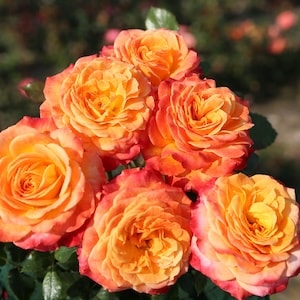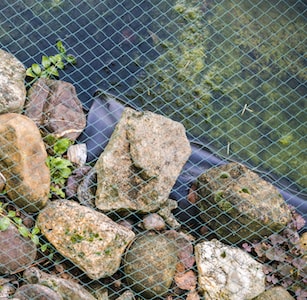What to do in your garden in January
January is the coldest month of the year in the garden. But while the mercury continues to drop, you can use this time to tackle our checklist of jobs and prepare for the year ahead.
The start of the new year is the perfect time to create a plan for your garden. Once you’ve reviewed your successes and failures, ring the changes by browsing through our catalogue and making a list of the flowers, fruits and vegetables you want to grow in the coming months. Get your veg plot off to an early start by sowing January vegetable seeds, and it’s a great time to plant bare root fruit bushes and roses too.

Image: Rose plant ‘Meteor’
Flowering plants in January
- Sow antirrhinum, begonia, geranium, lobelia, sweet pea and verbena seeds. Some perennial plants such as anemone, auricular, aquilegia, hollyhock and kniphofia can also be sown at this time.
- Pinch out the tips of your autumn-sown sweet pea seedlings to encourage side shoots.
- Plant bare-root roses this month. Allow plenty of space for the mature rose to develop, and plant in an area that gets at least 4 hours of sunlight a day.
- Deadhead winter-flowering houseplants like cyclamen and keep them in a cool, light position to prolong flowering.
- Spread mulch over beds planted with spring flowering bulbs before they emerge from the soil.
- Plant hippeastrum (amaryllis) bulbs this month in pots filled with good quality multi-purpose compost. The bulbs will flower 6 to 8 weeks after planting if kept in a bright and warm place.
- Bulbs, corms and tubers that are being kept in store should be checked regularly. Remove any that show symptoms of disease or rot.
Check out the full range of flowers to sow in January
Vegetables in January
- Chit your first early seed potatoes in a light, cool, frost-free place ready for planting in February and March.
- Sow broad beans ‘Aquadulce Claudia’ and ‘The Sutton’ outdoors this month under cloches.
- Make early sowings of aubergine and chilli pepper seeds at the end of this month in a heated propagator.
- Sow summer-maturing cauliflower seeds in the greenhouse.
- Sow onion seeds in the greenhouse this month, like exhibition onion ‘Ailsa Craig’. Harden the onion plants off in March, prior to planting outdoors in April.
- Prepare your vegetable beds for sowing runner beans by digging out and filling a long trench with well-rotted compost. In April, cover the filled trench with soil and sow your runner bean seeds directly on top.
Browse the full range of vegetables to sow in January
Fruit in January
- Plant raspberries and other soft fruit plants in well drained fertile soil in a place that receives full sun. Improve your soil prior to planting by forking in organic matter or good quality multi-purpose compost.
- Prune established hardy fruit bushes and trees during periods of frost-free weather.
- Remove any old stems from two year old whitecurrant and redcurrant bushes with clean sharp secateurs to avoid overcrowding. Prune back the side shoots so only one to three buds remain.
- Place forcing jars over dormant clumps of rhubarb. Allow a small amount of light to reach the rhubarb to encourage longer stems and an early harvest.
- Keep rain off nectarine and peach trees to reduce the risk of peach leaf curl disease. Move potted trees into a sheltered greenhouse or cover trees with plastic sheeting.
Pots, baskets, and containers in January
- Improve drainage and reduce waterlogging by standing patio pots up on feet, so they’re slightly raised from direct contact with the ground. Move pots to a sheltered position during very cold spells.
- Move evergreen container shrubs into a cold greenhouse or cold frame to protect them from frost damage. Alternatively use bubble wrap or a plant jacket/giant fleece bag to wrap around pots.

Image: Hotbin Mini Composter
General January garden jobs
- Plant bare root fruit trees this month. Prepare the soil before planting with a good all purpose fertiliser, remember to stake your trees properly during planting and water well until the tree is established. Check out our general guide to planting and growing fruit trees to find out more.
- Check tree ties and stakes for loosening or wear and tear.
- Give the leaves of indoor plants a thorough clean this month using a cool damp cloth. Make sure to remove built up dust, and check your plants over for mites or scale.
- If you used a Christmas tree to celebrate the festive season, why not shred your spent tree and use the chippings in the garden as mulch.
- Continue clearing fallen leaves and wind blown debris in January. Check gutters, drains and pathways to keep them clear. Add any leaves to a leaf bin or the compost heap.
- Wash glass panels in the greenhouse to remove dirt and grime. It’s also a good idea to empty and clean water-butts. Trays and pots can be cleaned now ready for use in the spring.
- Dig over empty garden beds, forking in plenty of well-rotted manure, organic matter or compost. Use wire netting to protect raked and prepared outdoor seedbeds, pots and trays from damage by squirrels.
- Use fleece or netting to protect vulnerable plants from severe frosts.
- Use insect glue to protect fruit trees from pests like the winter moth.
January pond care
- Keep pond netting in place to prevent any falling leaves or debris from going in. Also if any filters or pumps haven’t been removed yet it may be worthwhile doing so to prevent damage from freezing temperatures.
- Keep putting bird food out this month, remembering to place feeders out of reach of predators.

Image: Shutterstock
Suttons Seeds recommend these areas which may also be of interest.
More Monthly Gardening Tasks by Month
- Previous month: Jobs to do in your garden in December
- Next month: Jobs to do in your garden in February




